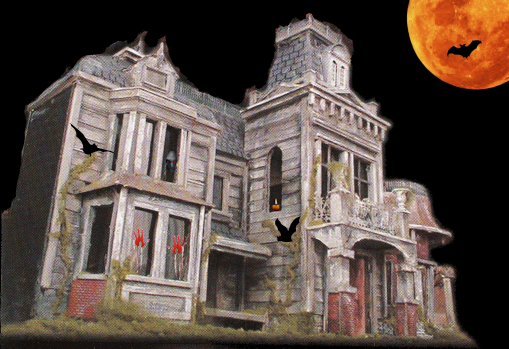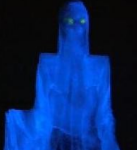Even though summer hasn’t officially begun yet, our countdown to Halloween has, so each week we will bring you a different summer haunted attraction from across the country and around the world.
Today we bring you a story from hauntednight.com about Japan’s ‘ghost houses’ where people go to escape the heat of summer and scare up some chills; enjoy!
Visit a “Ghost House” for Summer Chills
It’s the dead of summer, and you’re suffering from sweltering temperatures and oppressive humidity. You want to cool off, so you head to the local pool, a water park, an air conditioned shopping center, or your local haunted house. Uh, did you say “haunted house”? That’s right. If you live in Japan in the middle of summer, it’s not uncommon for people who want a “summer chill” to visit one of Japan’s many haunted houses or “obake-yashiki” (literally, “ghost house”).
The obake-yashiki is often open only in summer months and in large amusement parks or entertainment venues. It’s believed that the scares and chills you experience at an obake-yashiki can help cool down the body amid the summer heat.
So exactly what is an obake-yashiki? A haunted house—yes—but it differs somewhat from the North American convention of a haunted house both in terms of presentation and scares.
Traditional obake-yashiki are often centered around old ghost stories and supernatural beings from Japanese folklore, such as yurei (ghosts that return to the physical world because a person has died a sudden or violent death or with unresolved hatred, revenge, love or sorrow), yuki-onna (the “snow woman” who preys on men stranded in the snow), and rokurokubi (a supernatural being that appears as human during the day but at night has the ability to stretch its neck to great lengths to feed on people). Scenes with characters resembling these beings are not uncommon in a Japanese haunted house.
The first thing you may notice when visiting an obake-yashiki is that it is downright creepy. The traditional obake-yashiki makes little use of blood or gore and instead relies on the “creep factor”: a run-down old building, an abandoned house, furniture and items scattered in disarray in a dimly lit space, a room with antique-looking Japanese dolls, some missing limbs and heads. Not exactly scary, but creepy to the core—just what’s needed to build up the tension and prepare the visitors for the real scare that is to come.
The obake-yashiki is often set in a traditional Japanese setting to re-create the environment of ancient ghost stories. Just as a dark, cobweb-covered, Victorian-style parlor room with wall pictures askew may invoke an image of a haunted mansion, an old, damp and creepy Japanese-style room with rotted tatami mats and torn sliding doors invokes the same haunted feel in the obake-yashiki. There is an increasing trend of using hospitals and schools as other haunted settings, as well as scenes that are directly tied in with recent J-horror movies.
 The largest haunted attraction in Japan is the Haunted Hospital in the Fuji-Q Highland amusement park just outside of Tokyo. Once listed in the Guinness Book of World Records as the longest haunt in the world, at 900 meters or half a mile, this 60-minute walkthrough is filled to the gills with creepy ambience, well-positioned scares, and talented actors.
The largest haunted attraction in Japan is the Haunted Hospital in the Fuji-Q Highland amusement park just outside of Tokyo. Once listed in the Guinness Book of World Records as the longest haunt in the world, at 900 meters or half a mile, this 60-minute walkthrough is filled to the gills with creepy ambience, well-positioned scares, and talented actors.
Another thing you may notice is that “ghost houses” are very heavy on decorated sets and static props and make less use of animatronics than their Western counterparts. The level of haunt technology in Japan is not on the same level as that of the U.S., the leader in innovative haunted props. Though more and more haunt technology is making its way from other countries to Japan, most static and animatronic props in the obake-yashiki must be made by hand and, therefore, require more time to achieve the same result.
As in Western haunted houses, Japanese ghost houses also employ actors at key points within the haunt, but more as a startle than as a “scream-in-your-face” type of scare. You won’t find a chainsaw-wielding actor chasing you up and down the halls. Japanese ghosts are thought to haunt a specific place—the place where the hatred, sorrow, or violent death occurred—thus ghost actors are commonly positioned in a scene within the haunted house that reflects the location where he or she was wronged in mortal form.
Contrasts of black and white are common elements of characters in the obake-yashiki. The long, black and disheveled hair and hollow black eyes set against the clown-white makeup and traditional white burial kimono is the standard look of yurei in the Japanese haunted house. Think Sadako from “The Ring” or the ghosts in the “Grudge” series. Adding in some fake blood against the monochrome makeup and costume makes for an even more dramatic contrast.
Despite the many differences, the common element in both Japanese and Western haunted houses are the constant screams you will hear from frightened visitors who ultimately become “chilled to the bone”.
A great source for the background to the Japanese perspective of horror can be found in this excellent article.



